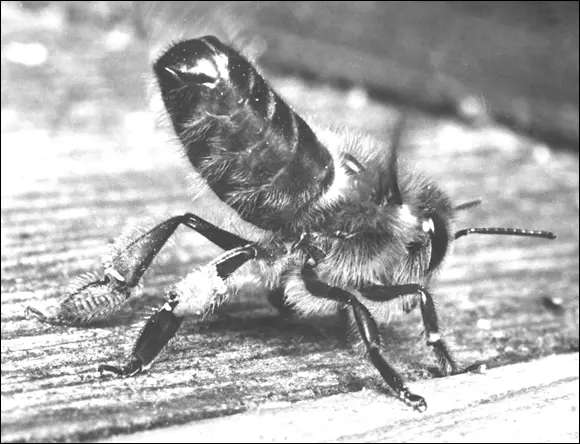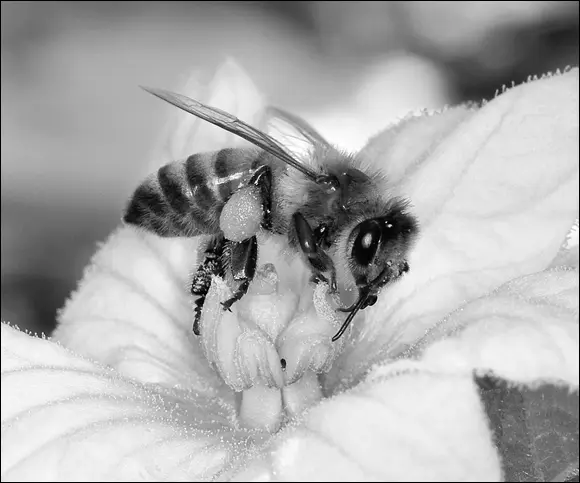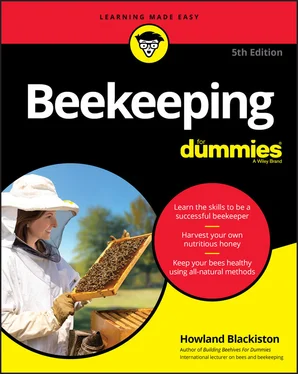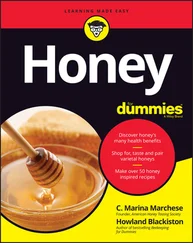Housekeeping (days 1 to 3)
A worker bee is born with the munchies. Immediately after she emerges from the cell and grooms herself, she engorges herself with pollen and honey. Following this binge, one of her first tasks is cleaning out the cell from which she just emerged. This cell and other empty cells are cleaned and polished and left immaculate to receive new eggs or to store nectar and pollen.
Undertaking (days 3 to 16)
The honey bee hive is one of the cleanest and most sterile environments found in nature. Preventing disease is an important early task for the worker bee. During the first couple weeks of her life, the worker bee removes any bees that have died and disposes of the corpses as far from the hive as possible. Similarly, diseased or dead brood are quickly removed before becoming a health threat to the colony.
Should a larger invader (such as a mouse) be stung to death within the hive, the workers utilize propolis to deal with that situation. Obviously a dead mouse is too big for the bees to carry off. So the workers completely encase the corpse with propolis (a brown, sticky resin collected from trees and sometimes referred to as bee glue ). Propolis has significant antibacterial qualities. In the hot, dry air of the hive, the hermetically sealed corpse becomes mummified and is no longer a source of infection. The bees also use propolis to seal cracks and varnish the inside walls of the hive.
Working in the nursery (days 4 to 12)
The young worker bees tend to their baby sisters by feeding and caring for the developing larvae. On average, nurse bees check a single larva 1,300 times a day. They feed the larvae a mixture of pollen and honey, and royal jelly — rich in protein and vitamins — produced from the hypopharyngeal gland in the worker bee’s head. The number of days spent tending brood depends on the amount of brood in the hive and the urgency of other competing tasks.
Attending royalty (days 7 to 12)
Because her royal highness is unable to tend to her most basic needs by herself, some of the workers do these tasks for her. They groom and feed the queen and even remove her excrement from the hive. These royal attendants also coax the queen to continue to lay eggs as she moves about the hive.
Stocking the pantry (days 12 to 18)
During this stage of their life, young worker bees take nectar from foraging field bees that are returning to the hive. These house bees deposit this nectar into cells earmarked for this purpose. They add an enzyme to the nectar and set about fanning the cells to evaporate the water content and turn the nectar into ripened honey. The workers similarly take pollen from returning field bees and pack the pollen into other cells. Both the ripened honey and the pollen, which is often referred to as bee bread, are food for the colony.
Worker bees also take a turn at controlling the temperature and humidity of the hive. During warm weather and during the honey flow season, you’ll see groups of bees lined up at one side of the entrance, facing the hive. They fan furiously to draw air into the hive. Additional fanners are in position within the hives. This relay of fresh air helps maintain a constant temperature (93 to 95 degrees Fahrenheit [34 to 35 degrees Celsius]) for developing brood. The fanning also hastens the evaporation of excess moisture from the curing honey. Chapter 15takes a detailed look at what makes honey so special.
ROYAL JELLY: THE FOOD OF ROYALTY
Royal jelly is the powerful, creamy substance that transforms an ordinary worker-bee egg into a queen bee and extends her life span from six weeks to several years! It’s made of digested pollen and honey or nectar mixed with a chemical secreted from a gland in a nurse bee’s head.
In health-food stores it commands premium prices, rivaling imported caviar. Those in the know use royal jelly as a dietary supplement and fertility stimulant. It contains an abundance of nutrients, including essential minerals, B-complex vitamins, proteins, amino acids, collagen, and essential fatty acids, just to name a few!
The workers also perform another kind of fanning, but it isn’t related to climate control. It has more to do with communication. The bees have a scent gland located at the end of their abdomen called the Nasonov gland. You’ll see worker bees at the entrance with their abdomens arched and the moist pink membrane of this gland exposed (see Figure 2-7). They fan their wings to release this pleasant, sweet odor into the air. You can actually smell it sometimes as you approach the hive. The pheromone is highly attractive and stimulating to other bees and serves as an orientation message to returning foragers, saying: “Come hither, this is your hive and where you belong.”
Beekeepers can purchase synthetic queen-bee pheromone and use this chemical to lure swarms of bees into a trap. The captured swarm then can be used to populate a new hive.

Courtesy of Bee Culture Magazine
FIGURE 2-7:This worker bee fans her wings while exposing her Nasonov gland to release a sweet orientation scent. This helps direct other members of the colony back to the hive.
Becoming architects and master builders (days 12 to 35)
Worker bees that are about 12 days old are mature enough to begin producing beeswax. These white flakes of wax are secreted from wax glands on the underside of the worker bee’s abdomen. They help with the building of new wax comb and in the capping of ripened honey and brood cells containing developing pupae.
Some new beekeepers are alarmed when they first see these wax flakes on the bee. They wrongly think these white chips are an indication of a disease or mite problem. While working, numbers of the wax flakes will fall to the bottom. Nothing to be alarmed about.
Guarding the home (days 18 to 21)
The last task of a house bee before she ventures out is that of guarding the hive. At this stage of maturity, her sting glands have developed to contain an authoritative amount of venom. You can easily spot the guard bees at the hive’s entrance. They are poised and alert, checking each bee that returns to the hive for a familiar scent. Only family members are allowed to pass. Strange bees, wasps, hornets, and other creatures intent on robbing the hive’s vast stores of honey are bravely driven off.
Bees from other hives are occasionally allowed in when they bribe the guards with nectar. These bees simply steal a little honey or pollen and then leave.
When the worker bee is a few weeks old, she ventures outside the hive to perform her last and perhaps most important job — to collect the pollen and nectar that will sustain the colony. With her life half over, she joins the ranks of field bees until she reaches the end of her life.
It’s not unusual to see field bees taking their first orientation flights. The bees face the hive and dart up, down, and all around the entrance. They’re imprinting the look and location of their home before beginning to circle the hive and progressively widening those circles, learning landmarks that ultimately will guide them back home. At this point, worker bees are foraging for pollen (see Figure 2-8), nectar, water, and propolis (resin collected from trees).

Courtesy of USDA-ARS, Stephen Ausmus
Читать дальше














